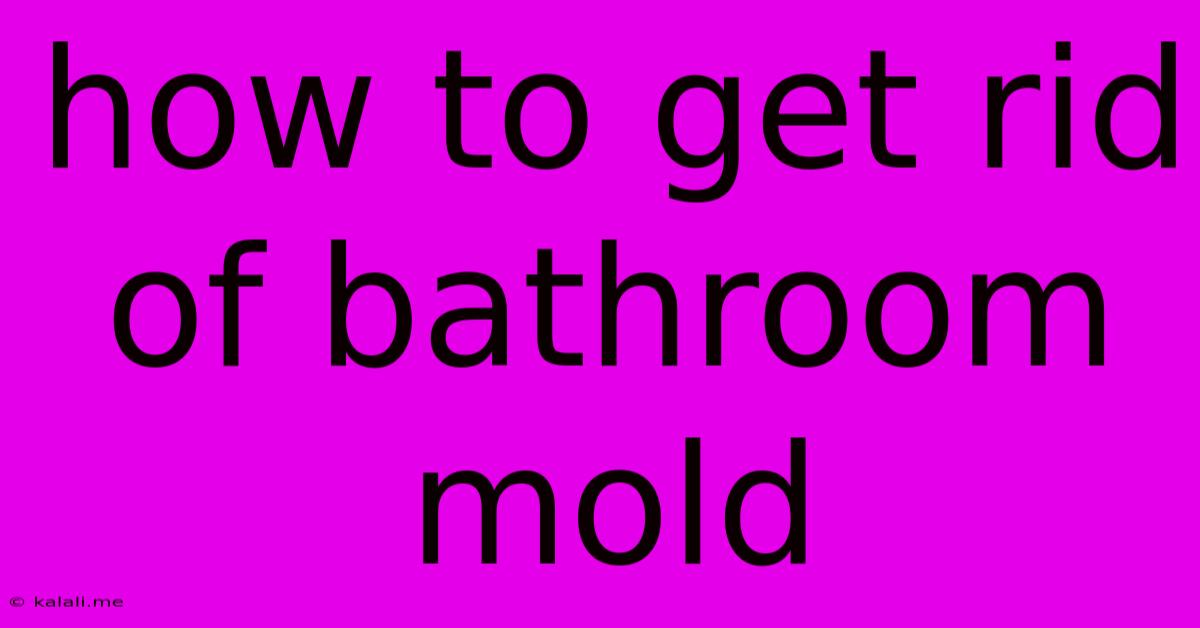How To Get Rid Of Bathroom Mold
Kalali
May 28, 2025 · 3 min read

Table of Contents
How to Get Rid of Bathroom Mold: A Complete Guide
Mold in the bathroom is a common problem, but it's not something to ignore. Not only is it unsightly, but it can also trigger allergies and respiratory problems. This comprehensive guide will walk you through how to effectively remove bathroom mold and prevent its return. This includes identifying mold, choosing the right cleaning solutions, and implementing preventative measures to keep your bathroom mold-free.
Understanding Bathroom Mold: Bathroom mold thrives in damp, humid environments. Leaking pipes, poor ventilation, and inadequate cleaning create the perfect breeding ground for mold spores to germinate and spread, often appearing as black, green, or white spots on grout, caulk, shower walls, and ceilings. Identifying the source of the moisture is crucial for successful mold removal and prevention. Addressing the underlying problem prevents future growth.
Identifying the Type and Extent of Mold
Before you start cleaning, it's important to assess the extent of the mold infestation. A small patch of mold can often be handled with DIY methods. However, larger infestations, especially those covering significant areas or showing signs of deep penetration, may require professional remediation. Black mold, while not necessarily more dangerous than other types, often indicates a larger, more established problem and warrants extra caution. Always wear protective gear like gloves and a mask when dealing with mold.
Safe and Effective Mold Removal Methods
For smaller mold infestations, these steps are effective:
1. Preparation is Key: Protect yourself! Wear rubber gloves, eye protection, and an N95 respirator mask to prevent inhaling mold spores. Open windows to improve ventilation.
2. Gather Your Supplies: You'll need:
- A stiff-bristled brush or scrub brush
- A spray bottle
- Cleaning solution (see options below)
- Microfiber cloths or paper towels
- A bucket of clean water for rinsing
3. Choose Your Cleaning Solution: Several options exist for mold removal:
- Bleach Solution (For non-porous surfaces): Mix one cup of bleach with one gallon of water. Caution: Bleach can damage certain materials, so test it on an inconspicuous area first. Never mix bleach with ammonia or other cleaning products.
- Baking Soda Paste: Mix baking soda with water to create a paste. This is a gentler option for less severe mold and is suitable for porous surfaces.
- Commercial Mold Cleaners: Several effective commercial mold cleaners are available at most home improvement stores. Always follow the product instructions carefully.
4. Cleaning Process:
- Apply the cleaning solution: Spray the affected area generously, ensuring it's fully saturated.
- Scrub the mold: Use your brush or scrub to remove the mold thoroughly. Pay close attention to grout lines and caulking.
- Rinse thoroughly: Rinse the area with clean water to remove any residue.
- Dry completely: Ensure the area is completely dry to prevent mold regrowth. Use a fan or dehumidifier to assist in the drying process.
5. Addressing Larger Infestations: If the mold infestation is extensive or you're uncomfortable tackling it yourself, it's best to contact a professional mold remediation specialist. They have the expertise and equipment to safely and effectively remove significant mold growth.
Preventing Future Mold Growth
Prevention is key! Here's how to keep your bathroom mold-free:
- Improve Ventilation: Ensure your bathroom has adequate ventilation. Use an exhaust fan during and after showers. Open a window if possible.
- Fix Leaks Promptly: Repair any leaky pipes or faucets immediately. Even small leaks can create moisture buildup.
- Regular Cleaning: Clean your bathroom regularly, paying special attention to grout lines and caulking. Wipe down shower walls and floors after each use.
- Use a Dehumidifier: A dehumidifier can help control humidity levels, particularly in damp bathrooms.
- Caulk and Grout Maintenance: Inspect and replace damaged caulk and grout regularly.
By following these steps, you can effectively eliminate existing mold and prevent future infestations, keeping your bathroom clean, healthy, and mold-free. Remember, safety first! If you're unsure about any aspect of mold removal, consult a professional.
Latest Posts
Latest Posts
-
How Many Watts Does A Well Pump Use
May 30, 2025
-
Why Did Skyler Give The Money To Ted
May 30, 2025
-
How To Quit Vi In Linux
May 30, 2025
-
How To Set Imessage Link To A Specific Browser Mac
May 30, 2025
-
How Much Does The Same Type Move In Pokemon Matter
May 30, 2025
Related Post
Thank you for visiting our website which covers about How To Get Rid Of Bathroom Mold . We hope the information provided has been useful to you. Feel free to contact us if you have any questions or need further assistance. See you next time and don't miss to bookmark.